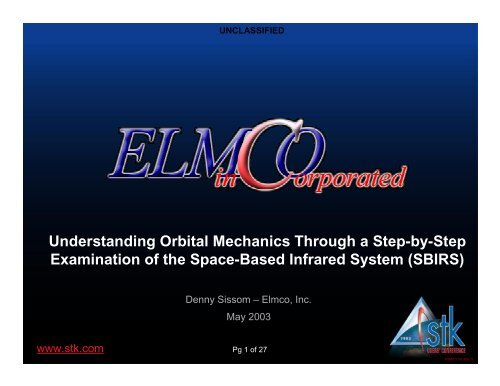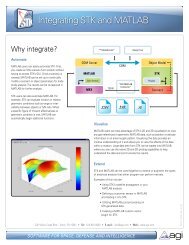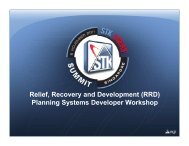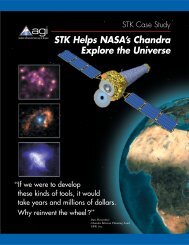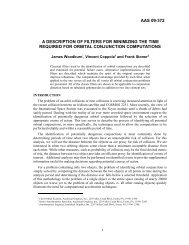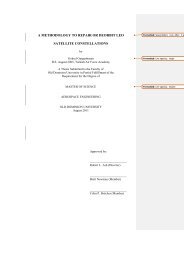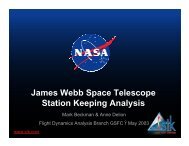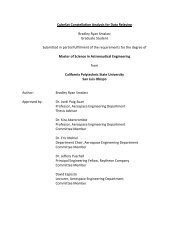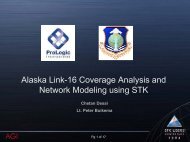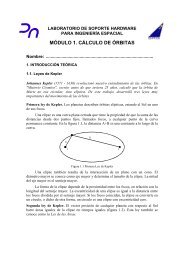Understanding Orbital Mechanics Through a Step-by-Step ... - AGI
Understanding Orbital Mechanics Through a Step-by-Step ... - AGI
Understanding Orbital Mechanics Through a Step-by-Step ... - AGI
Create successful ePaper yourself
Turn your PDF publications into a flip-book with our unique Google optimized e-Paper software.
UNCLASSIFIED<br />
<strong>Understanding</strong> <strong>Orbital</strong> <strong>Mechanics</strong> <strong>Through</strong> a <strong>Step</strong>-<strong>by</strong>-<strong>Step</strong><br />
Examination of the Space-Based Infrared System (SBIRS)<br />
Denny Sissom –Elmco, Inc.<br />
May 2003<br />
www.stk.com<br />
Pg 1 of 27<br />
UNCLASSIFIED<br />
SSMD-1102-366 [1]
The Ground-Based Midcourse<br />
Defense Architecture (2004)<br />
UNCLASSIFIED<br />
SSMD-0403-433 [2]<br />
• Radars<br />
• IFICS (In-Flight Interceptor Communications System)<br />
• Ground-Based Interceptors<br />
• Battle Management (BMC3)<br />
• Space-Based Infrared System (SBIRS)<br />
– SBIRS High GEO (Geo-Stationary Orbits)<br />
– SBIRS High HEO (Highly-Elliptical Orbits)<br />
– SBIRS Low (Low-Altitude Orbits)<br />
– SBIRS Ground Station Processing (MCS)<br />
www.stk.com<br />
Pg 2 of 27<br />
UNCLASSIFIED
UNCLASSIFIED<br />
SBIRS Model Overview<br />
SBIRS High<br />
Launch Detection<br />
Boost Tracking<br />
SBIRS Communication<br />
Mission<br />
Control<br />
Station<br />
(MCS)<br />
Launch Detection<br />
Boost Tracking<br />
DSP/GEO<br />
2D Detection<br />
Report<br />
Mission Control Station<br />
•• One One Central CONUS Location<br />
•Boost and and Coast Tracking<br />
•Booster Typing<br />
•Launch Point Estimation<br />
•Impact Point Prediction<br />
SBIRS Architecture<br />
– Four Satellites in Geostationary<br />
Orbits (GEO)<br />
– Two Satellites in Highly<br />
Elliptical Orbits (HEO)<br />
– Twenty or more<br />
Satellites in Low Earth<br />
Orbit (LEO)<br />
– Ground-Based Mission<br />
Control Station (MCS)<br />
SBIRS Low<br />
Launch Detection<br />
Boost Tracking<br />
Mid-Course<br />
Tracking<br />
Discrimination<br />
DSP Payload<br />
• Scanner Only<br />
-SWIR Band<br />
-Periodic Revisit<br />
• GEO Satellites<br />
• Rotating Platform<br />
• Provides 2D<br />
Detection Reports to<br />
MCS<br />
LEO Payload<br />
• Acquisition Sensor<br />
-Wide FOV (WFOV)<br />
-SWIR Band<br />
-Boost Detection<br />
• Track Sensor<br />
-Narrow FOV<br />
(NFOV)<br />
-Multiple Wavebands<br />
-2-Axis Gimbal<br />
Control<br />
-Precise Midcourse<br />
Acquisition,<br />
Tracking, &<br />
Discrimination<br />
GEO<br />
Payload<br />
• Scanner<br />
–Rapid Global<br />
Coverage<br />
–SWIR, MWIR<br />
Bands<br />
–Taskable Scan<br />
Rate and Revisit<br />
• Starer<br />
–SWIR, MWIR<br />
Bands<br />
–Taskable Revisit<br />
• Follow-on and<br />
replacement for<br />
DSP<br />
SSMD-0403-433 [3]<br />
HEO Payload<br />
• Highly Elliptical<br />
Orbit (HEO)<br />
• Scanner Only<br />
- SWIR, MWIR<br />
Bands<br />
- Taskable Scan<br />
Rate and Revisit<br />
www.stk.com<br />
Pg 3 of 27<br />
UNCLASSIFIED
UNCLASSIFIED<br />
SBIRS Concept of Operations<br />
Animation Showing Concept of Operations<br />
From www.stk.com<br />
• SBIRS High (GEO and/or HEO)<br />
Acquire Target (SBIRS Low Can<br />
Also Acquire Target)<br />
• Data Transmitted From SBIRS<br />
High To Mission Control Station<br />
(MCS)<br />
• Track Data Is Transmitted From<br />
MCS To SBIRS Low<br />
• SBIRS Low Acquires And Hands<br />
Data Over From Acquisition<br />
Sensor To Track Sensor<br />
• Data Handed Over To Other SBIRS<br />
Low Spacecraft and MCS<br />
• Track Data Sent From<br />
MCS To Battle Manager<br />
SSMD-0403-433 [4]<br />
www.stk.com<br />
Pg 4 of 27<br />
UNCLASSIFIED
UNCLASSIFIED<br />
Kepler’s Laws<br />
SSMD-0403-433 [5]<br />
Area 1 = Area 2<br />
Planetary<br />
Motion over<br />
30 Days<br />
Area 1<br />
Area 2<br />
Planetary<br />
Motion over<br />
30 Days<br />
Average Distance<br />
• Kepler’s First Law: The Orbits of Planets (or Satellites) are Ellipses with the Sun at a Focus<br />
• Kepler’s Second Law: The Orbits of the Planets Sweep Out Equal Areas in Equal Time<br />
• Kepler’s Third Law: The Square of the Orbit Period (The Time it Takes to Go Around Once)<br />
is Proportional to the Cube of the Average Distance to the Sun<br />
P<br />
=<br />
2π<br />
www.stk.com<br />
a<br />
μ<br />
3<br />
Where:<br />
P = Period (sec)<br />
a = Semi-Major Axis (km)<br />
m= Gravitational Parameter (km 3 /s 2 ) = GM earth<br />
G = Universal Gravitational Constant (Nm 2 /kg 2 )<br />
M earth<br />
= Mass of the Earth (kg)<br />
Pg 5 of 27<br />
UNCLASSIFIED
UNCLASSIFIED<br />
Newton’s Law and the Restricted Two-<br />
Body Equation of Motion<br />
F<br />
v<br />
ma<br />
Newton’s Second Law<br />
SSMD-0403-433 [6]<br />
v<br />
=<br />
2<br />
−<br />
µ<br />
R<br />
E<br />
2<br />
m<br />
F g<br />
=<br />
Gm m<br />
1<br />
R<br />
r − µ<br />
E<br />
F m<br />
g<br />
=<br />
2<br />
R<br />
v<br />
R<br />
R<br />
v<br />
= ma<br />
2<br />
v<br />
R<br />
R<br />
= mR<br />
& v<br />
v<br />
R<br />
R<br />
& v µ<br />
+ = 0<br />
2<br />
R R<br />
Newton’s Law of Universal Gravitation<br />
Newton’s Law of Universal Gravitation in<br />
Vector Form with Earth as Central Body<br />
(m E = GM earth = 3.986 x10 14 m 3 /s 2 )<br />
Combining Newton’s Two Laws, assuming:<br />
(1) No perturbations (drag, earth’s oblateness, other planets, etc.)<br />
(2) Bodies are spherically symmetric<br />
(3) m 1 >> m 2<br />
We Get the Restricted Two-Body Equation of<br />
Motion Which is a Second-Order, Non-Linear,<br />
Vector Differential Equation – YUK!<br />
This Equation Represents a Conic Section (Circle, Ellipse, Parabola, or Hyperbola)<br />
www.stk.com<br />
Pg 6 of 27<br />
UNCLASSIFIED
UNCLASSIFIED<br />
A Few More Useful Equations for<br />
<strong>Orbital</strong> <strong>Mechanics</strong><br />
E<br />
=<br />
v<br />
H<br />
1<br />
2<br />
v v<br />
R × mV<br />
v v v<br />
h = R × V<br />
= Angular Momentum<br />
mV<br />
2<br />
mµ<br />
−<br />
R<br />
Specific Angular Momentum, where<br />
v<br />
h ≡<br />
Total Mechanical Energy for Orbiting Spacecraft<br />
(Must remain constant!)<br />
Apogee:<br />
High PE = -mµ/R<br />
Low KE = ½ mV 2<br />
E<br />
Earth<br />
v<br />
H<br />
m<br />
Perigee:<br />
Low PE = -mµ/R<br />
High KE = ½ mV 2<br />
SSMD-0403-433 [7]<br />
ε<br />
V 2<br />
= −<br />
µ<br />
2 R<br />
ε<br />
=<br />
−<br />
µ<br />
2a<br />
Specific Mechanical Energy, where<br />
Shows We can Easily Find Specific Mechanical Energy Just<br />
Knowing the Semi-Major Axis<br />
- e is negative for circles and ellipses<br />
- e is zero for parabolas<br />
- e is positive for hyperbolas<br />
ε<br />
≡<br />
E<br />
m<br />
www.stk.com<br />
Pg 7 of 27<br />
UNCLASSIFIED
Geocentric – Equatorial<br />
Coordinate System<br />
UNCLASSIFIED<br />
SSMD-0403-433 [8]<br />
• Origin –Center of Earth<br />
• Fundamental Plane –Earth’s Equator<br />
• Principle Direction (I-Axis)<br />
– Vernal Equinox Direction Found <strong>by</strong> Drawing a Line from the Earth to the<br />
Sun on the First Day of Spring<br />
– Points at First Star in Aries Constellation (First Point of Aries)<br />
– Denoted <strong>by</strong> Ram’s Head Symbol –<br />
– Wanders Due to Earth Spin-Axis Wobble<br />
– Because of the Wobble, Sometimes the Vernal Equinox Direction is<br />
Specified at a Certain Time or “Epoch”<br />
– Fixed at Vernal Equinox direction at Noon on January 1, 2000 at<br />
Greenwich Meridian <strong>by</strong> International Astronomical Union (More Truly<br />
Inertial)<br />
• K-Axis<br />
– North Pole<br />
www.stk.com<br />
Pg 8 of 27<br />
UNCLASSIFIED
UNCLASSIFIED<br />
Semi-Major Axis and Eccentricity<br />
The Size and Shape of a Orbit<br />
SSMD-0403-433 [9]<br />
e > 1<br />
Semi-Major Axis<br />
e = 1<br />
Apogee radius<br />
Perigee radius<br />
Apogee Altitude<br />
Perigee Altitude<br />
Apogee<br />
Center of<br />
Ellipse<br />
C<br />
Perigee<br />
0 < e < 1<br />
e = 0<br />
C = distance from center of Earth to center<br />
of ellipse = eccentricity * semi major axis<br />
ellipse<br />
circle<br />
• Size Determination: Semi-Major Axis<br />
• Shape Determination: Eccentricity<br />
www.stk.com<br />
Pg 9 of 27<br />
UNCLASSIFIED
Inclination<br />
The Orientation of an Orbit<br />
UNCLASSIFIED<br />
• Tilt of <strong>Orbital</strong> Plane with Respect to Fundamental Plane (of Geocentric-<br />
Equatorial Coordinate System)<br />
• Angle Between Specific Angular Momentum Vector ( h = R × V ) and the<br />
Vector Perpendicular to the Fundamental Plane Pointing <strong>Through</strong> the<br />
North Pole (K-axis)<br />
Inclination<br />
<strong>Orbital</strong> Type<br />
Diagram<br />
• Ranges from 0° to 180°<br />
Î<br />
ĥ<br />
i<br />
Kˆ<br />
Ĵ<br />
0 or 180<br />
90<br />
0 £i < 90<br />
90 < i £ 180<br />
Equatorial<br />
Polar<br />
Direct or Prograde (Moves<br />
in the Direction of Earth’s<br />
Rotation)<br />
Indirect or Retrograde<br />
(Moves Against the<br />
Direction of Earth’s<br />
Rotation)<br />
v<br />
v<br />
v<br />
i =<br />
90°<br />
Ascending<br />
node<br />
Ascending<br />
node<br />
SSMD-0403-433 [10]<br />
www.stk.com<br />
Pg 10 of 27<br />
UNCLASSIFIED
UNCLASSIFIED<br />
Right Ascension of Ascending Node (RAAN or Ω)<br />
The “Swivel” of an Orbit<br />
• Angle, Along the Equator, Between Principle Direction (i.e., First Point<br />
of Aries) and the Point Where the <strong>Orbital</strong> Plane Crosses the Equator,<br />
from South to North (The Ascending Node), Measured Eastward<br />
• Not the Same As the Longitude of the Ascending Node<br />
– RAAN Relative to Inertial Frame (Geocentric-Equatorial)<br />
– Longitude of Ascending Node Relative to Rotating Earth<br />
• Ranges from 0° to 360°<br />
Kˆ<br />
SSMD-0403-433 [11]<br />
Î<br />
Equatorial<br />
Plane<br />
Ω<br />
Ĵ<br />
Ascending<br />
Node<br />
www.stk.com<br />
Pg 11 of 27<br />
UNCLASSIFIED
UNCLASSIFIED<br />
Argument of Perigee (ω)<br />
The Orientation of the Orbit within the <strong>Orbital</strong> Plane<br />
SSMD-0403-433 [12]<br />
• Angle Along <strong>Orbital</strong> Path Between the Ascending Node and the Perigee<br />
• Always measured Along the <strong>Orbital</strong> Path in Direction of Spacecraft<br />
Motion<br />
• Perigee – Closest Approach to Earth<br />
• Ranges from 0° to 360°<br />
Kˆ<br />
Perigee<br />
ω<br />
Ĵ<br />
Î<br />
www.stk.com<br />
Pg 12 of 27<br />
UNCLASSIFIED
UNCLASSIFIED<br />
True Anomaly at Epoch<br />
The Spacecraft’s Location within an Orbit<br />
SSMD-0403-433 [13]<br />
• Angle Along <strong>Orbital</strong> Path from Perigee to Spacecraft’s Position<br />
• Always Measured Along <strong>Orbital</strong> Path in Direction of Spacecraft Motion<br />
• The Only <strong>Orbital</strong> Element Set Parameter That Varies with Time as the<br />
Spacecraft Travels Around its Fixed Orbit, Assuming a Spherically-<br />
Symmetric Earth (A So-So Assumption)<br />
Vˆ<br />
Rˆ<br />
ν<br />
Perigee<br />
www.stk.com<br />
Pg 13 of 27<br />
UNCLASSIFIED
UNCLASSIFIED<br />
Summary of <strong>Orbital</strong> Elements<br />
SSMD-0403-433 [14]<br />
Element<br />
Name<br />
Description<br />
Range of Values<br />
Undefined<br />
a<br />
Semimajor Axis<br />
Size<br />
Depends on the<br />
Conic Section<br />
Never<br />
e<br />
Eccentricity<br />
Shape<br />
e = 0: Circle<br />
0 < e < 1: ellipse<br />
Never<br />
i<br />
Inclination<br />
Tilt, angle from Kˆ unit<br />
vector to specific<br />
angular momentum<br />
vector ĥ<br />
0 £i £ 180<br />
Never<br />
W<br />
Right ascension<br />
of the ascending<br />
node<br />
Swivel, angle from<br />
vernal equinox to<br />
ascending node<br />
0 £W£360<br />
When i = 0 or 180<br />
(equatorial orbit)<br />
w<br />
Argument of<br />
perigee<br />
Angle from ascending<br />
node to perigee<br />
0 £w£360<br />
When i = 0 or 180<br />
(equatorial orbit) or e = 0<br />
(circular orbit)<br />
n<br />
True anomaly<br />
Angle from perigee to<br />
the spacecraft’s position<br />
0 £n£360<br />
When e = 0 (circular orbit)<br />
www.stk.com<br />
Pg 14 of 27<br />
UNCLASSIFIED
UNCLASSIFIED<br />
Alternate <strong>Orbital</strong> Elements<br />
Element<br />
u<br />
• A Circular Orbit<br />
– No Argument of Perigee<br />
– No True Anomaly<br />
• An Equatorial Orbit<br />
– No RAAN<br />
– No Argument of Perigee<br />
Name<br />
Argument of<br />
latitude<br />
What Do We Do With:<br />
Description<br />
Angle from ascending node<br />
to the spacecraft’s position<br />
• A Circular Equatorial Orbit<br />
– No RAAN<br />
– No Argument of Perigee<br />
– No True Anomaly<br />
Range of Values<br />
0 £u£360<br />
Undefined<br />
SSMD-0403-433 [15]<br />
Use when there is no perigee (e =<br />
0)<br />
P<br />
Longitude of<br />
perigee<br />
Angle from the principal<br />
direction to perigee<br />
0 £P£360<br />
Use when equatorial (i = 0 or<br />
180 ) because there is no<br />
ascending node<br />
l<br />
True longitude<br />
Angle from the principal<br />
direction to the spacecraft’s<br />
position<br />
0 £l£360<br />
Use when there is no perigee and<br />
ascending node (e = 0 and i = 0<br />
or 180 )<br />
www.stk.com<br />
Pg 15 of 27<br />
UNCLASSIFIED
UNCLASSIFIED<br />
SBIRS High Scenario<br />
SSMD-0403-433 [16]<br />
• SBIRS High is a “Molniya” Type Orbit<br />
• Russian word for “Zipper” or “Lightning”<br />
• Large Dwell Time over Northern Hemisphere<br />
• Usually a 12-Hour Orbit with High Eccentricity (0.7)<br />
and Perigee in Southern Hemisphere<br />
• Has Inclination of 63.4° (No Rotation of Perigee)<br />
• Covers High Latitudes and Polar Regions Very Well<br />
www.stk.com<br />
Pg 16 of 27<br />
UNCLASSIFIED
UNCLASSIFIED<br />
SBIRS Low Coverage Studies<br />
SSMD-0403-433 [17]<br />
SBIRS Low Constellation Showing Threat Object Coverage<br />
(Sensor Footprints in Green, Sensor Acquisitions in Yellow)<br />
• SBIRS Low Constellation As Implemented In TESS<br />
• Coverage Almost Complete Utilizing 24 Satellites<br />
• <strong>Orbital</strong> Element Set Propagation Within TESS<br />
www.stk.com<br />
Pg 17 of 27<br />
UNCLASSIFIED
SBIRS DSP (GEO)<br />
UNCLASSIFIED<br />
SSMD-0403-433 [18]<br />
From www.stk.com<br />
• Geostationary Orbits (Fixed ECR)<br />
• Above and Below-the-Horizon Viewing Ability<br />
www.stk.com<br />
Pg 18 of 27<br />
UNCLASSIFIED
UNCLASSIFIED<br />
In Summary<br />
• Excellent References<br />
– Expensive: <strong>Understanding</strong> Space – An Introduction to Astronautics, Jerry<br />
Jon Sellers<br />
$66.00 at www.walmart.com<br />
– Cheap: Fundamentals of Astrodynamics, Roger R. Bate<br />
$9.00 at www.walmart.com<br />
Introduction to Space Dynamics, William Tyrrell Thomson<br />
$9.00 at www.walmart.com<br />
– Free: TRW Space Data, Neville J. Barter, editor<br />
Free from TRW Space and Electronics Group<br />
• Excellent Web Site<br />
– www.heavens-above.com<br />
– Iridium Flares, ISS, HST, etc.<br />
• Excellent Software<br />
– Satellite Tool Kit from Analytical Graphics, Inc. (www.stk.com)<br />
– Price: Free to Over $100,000<br />
• Training Available for Basic <strong>Orbital</strong> <strong>Mechanics</strong><br />
www.stk.com<br />
Pg 19 of 27<br />
UNCLASSIFIED<br />
SSMD-0403-433 [19]
UNCLASSIFIED<br />
SSMD-0403-433 [20]<br />
Supplemental Charts<br />
www.stk.com<br />
Pg 20 of 27<br />
UNCLASSIFIED
UNCLASSIFIED<br />
Ground-Based Midcourse<br />
Defense Architecture (2004)<br />
SSMD-0403-433 [21]<br />
GBIs<br />
IFICS<br />
BMC3<br />
BMC3<br />
Cobra Dane<br />
IFICS<br />
GBIs<br />
IFICS<br />
UEWR<br />
GBIs<br />
IFICS<br />
BMC3<br />
GBR-P<br />
AEGIS<br />
GBIs<br />
SBIRS MCS<br />
IFICS<br />
www.stk.com<br />
Pg 21 of 27<br />
UNCLASSIFIED
UNCLASSIFIED<br />
GMD with SBIRS High and DSP<br />
SSMD-0403-433 [22]<br />
From www.stk.com<br />
www.stk.com<br />
Pg 22 of 27<br />
UNCLASSIFIED
UNCLASSIFIED<br />
SBIRS Waveband Utilization<br />
• SBIRS DSP, High, and Low<br />
Utilize Different Sensor<br />
Wavebands<br />
SBIRS High<br />
• MWIR (3-8 mm)<br />
• SWIR (1-3 mm)<br />
DSP/GEO<br />
• SWIR (1-3 mm)<br />
SSMD-0403-433 [23]<br />
• Different Target Types are Visible<br />
in Different Wavelengths<br />
• Synergy Between Satellites Allow<br />
Full Tracking of Threat Objects<br />
from Initial Launch <strong>Through</strong> Mid-<br />
Course<br />
PBVs<br />
PBV<br />
Plumes<br />
Upper<br />
Stage<br />
Boost<br />
Phase<br />
Low-<br />
Altitude<br />
Boost<br />
Phase<br />
• Provides Extended Capability for<br />
Strategic and Theater Missile<br />
Defense<br />
SBIRS Low<br />
• LWIR (8-14 mm)<br />
• MWIR (3-8 mm)<br />
• SWIR (1-3 mm)<br />
• Visible (0.4-0.7 mm)<br />
Mid-<br />
Course<br />
Tracking<br />
Visible Near Infrared Middle Infrared Far Infrared Extreme Infrared<br />
V B G Y OR<br />
0.4<br />
0.6<br />
0.8<br />
1<br />
1.5<br />
2<br />
3<br />
4<br />
6<br />
8<br />
10<br />
15<br />
20<br />
30<br />
www.stk.com<br />
Pg 23 of 27<br />
UNCLASSIFIED
UNCLASSIFIED<br />
Effects of Earth’s Oblateness<br />
on Orbiting Spacecraft<br />
22 km<br />
Rˆ<br />
F v<br />
J 2<br />
Nodal Regression Rate<br />
SSMD-0403-433 [24]<br />
22 km<br />
Perigee Rotation Rate<br />
.<br />
• Equatorial Bulge Causes Slight Shift in Direction<br />
Gravity Pulls Spacecraft<br />
• Modeled <strong>by</strong> Complex Mathematics Referred to as<br />
the “J2 Effect”<br />
• Earth is 22 km Bigger (radius) at Equator<br />
• Causes Nodal Regression Rate (Movement of the<br />
RAAN, Ω) and . a Perigee Rotation Rate (ω)<br />
www.stk.com<br />
Graphs from “<strong>Understanding</strong> Space” <strong>by</strong> Jerry Jon Sellers<br />
Pg 24 of 27<br />
UNCLASSIFIED
UNCLASSIFIED<br />
Sun Synchronous Orbits<br />
If Someone Gives You Lemons, Make Lemonade! (Part 1)<br />
SSMD-0403-433 [25]<br />
• Despite the Complexities That the “J2 Effect” Cause, There are Advantages<br />
• Sun-Synchronous Orbits Take Advantage of the Rate of Change of the RAAN<br />
• Inclination is Set to Give Approximately a One-Degree Nodal Regression Eastward per day (Note that the<br />
Earth Moves 0.9863 Degrees per day in its Orbit Around the Sun (i.e., 360 /365 days)<br />
• Spacecraft’s <strong>Orbital</strong> Plane Always Maintains Same Orientation to Sun<br />
– Spacecraft Always Sees Same Sun Angle When It Passes Over a Particular Point on Earth<br />
– Sun’s Shadows Cast <strong>by</strong> Objects on Earth’s Surface Will Not Change When Pictures are Taken Days or Weeks Apart<br />
– Good for Remote Sensing, Reconnaissance, Weather, etc.<br />
Earth moves<br />
around the Sun at<br />
1° /day<br />
<strong>Orbital</strong> plane<br />
rotates at ~1° /day<br />
due to earth’s<br />
oblateness<br />
Inclination = 97.03<br />
<strong>Orbital</strong> plane<br />
Sun line<br />
Sun angle<br />
www.stk.com<br />
Pg 25 of 27<br />
UNCLASSIFIED
UNCLASSIFIED<br />
Molniya Orbits<br />
If Someone Gives You Lemons, Make Lemonade! (Part 2)<br />
SSMD-0403-433 [26]<br />
• Another Advantage of the “J2 Effect”<br />
• Molniya –Russian word for “Zipper”<br />
or “Lightning”<br />
• Large Dwell Time over Northern<br />
Hemisphere<br />
• Usually a 12-Hour Orbit with High<br />
Eccentricity (0.7) and Perigee in<br />
Southern Hemisphere<br />
• Has Inclination of 63.4 (No Rotation<br />
of Perigee)<br />
• Covers High Latitudes and Polar<br />
Regions Very Well<br />
www.stk.com<br />
Pg 26 of 27<br />
UNCLASSIFIED
Geosynchronous Orbit<br />
No Perigee Rotation<br />
UNCLASSIFIED<br />
SSMD-0403-433 [27]<br />
• Orbits Every 24 Hours<br />
• Inclination of 63.4 degrees<br />
• No Perigee Rotation<br />
www.stk.com<br />
Pg 27 of 27<br />
UNCLASSIFIED


